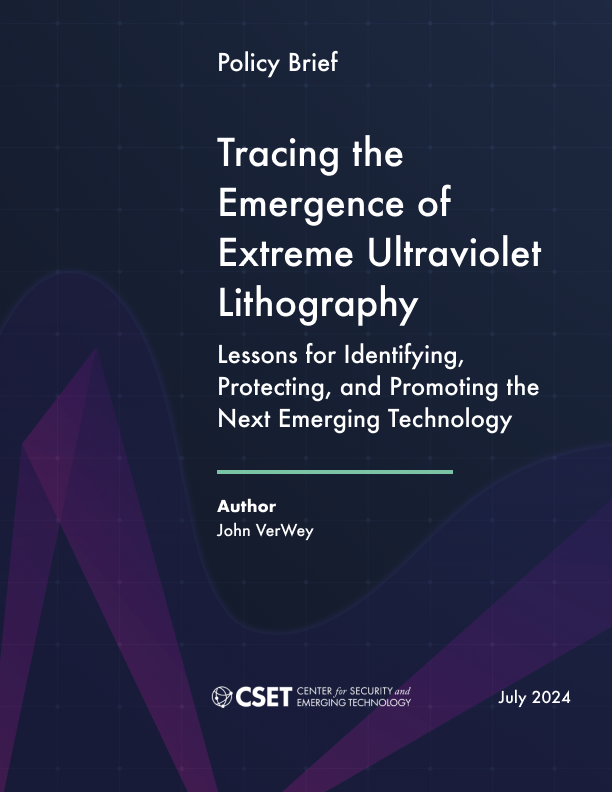Executive Summary
This paper presents a case study on the most important technology to have emerged in the past decade: extreme ultraviolet (EUV) lithography. In 2019, when the first commercial electronics enabled by EUV were released, the technology was hailed as “the machine that saved Moore’s Law.”1 All of today’s most advanced artificial intelligence (AI) chips, smartphones, autonomous driving systems, and high-performance computers contain semiconductors fabricated using EUV lithography. The Dutch company ASML has emerged as the sole supplier of EUV machines, winning a 30-year race that granted the company a monopoly on selling the tool essential for fabricating leading-edge semiconductors.2
However, while ASML gets well-deserved praise for developing and commercializing EUV, this paper’s focus is on the research community that supported EUV from the beginning: the academics in Japan, the United States, and Europe; the public-private partnerships; the conferences; and the industry collaboration that laid the groundwork for EUV in the 1980s and 1990s. Without this community, “the most technically advanced tool of any kind that’s ever been made” would not have been possible.3 This paper traces the academic, government, and industry actors involved in a multi-decade moon-shot project that ultimately saw EUV ascend from a speculative emerging technology to the mechanism that makes Nvidia’s leading-edge AI training chips and Apple’s latest smartphone possible.
Careful study of the research community that supported EUV development is particularly relevant for policymakers and the semiconductor industry today. EUV research began in the 1980s, when the U.S. semiconductor industry was trying to fend off ascendent Japanese firms amid significant government intervention on both sides. At the same time, the industry recognized that a new generation of lithographic light sources would be necessary to fabricate future advanced chips to maintain Moore’s law. Similar circumstances exist today, with policymakers in the United States, Europe, and Asia engaged in once-in-a-generation efforts to protect and promote their respective semiconductor industries, all while ascendent Chinese firms attempt to challenge industry leaders. Meanwhile, the entire semiconductor industry recognizes a slow-moving existential crisis: rapid advances in AI must be sustained by correspondingly rapid advances in computational power. However, the end of Moore’s law is in sight, and not even EUV can save it.4
The development of EUV reflects many of the emerging technology themes observed in previous CSET analyses.5 Research collaboration among academia, industry, and government has occurred for decades, making progress on associated technologies in fields such as materials science, plasma physics, and chemistry. This progress has been documented in the form of journal article publications, patent filings, and conference proceedings. Over time, specific technologies would transition from government labs to the private sector, frequently through public-private partnerships and consortia formed to address and overcome technical hurdles. Eventually a private firm would assess a market opportunity, make investments to increase the technology’s maturity, collaborate with customers, and commercialize the technology. Government support has always been essential at various points along the way.
Bibliometric study of the EUV research community during the period when EUV was still “emerging” offers important lessons for policymakers interested in identifying promising technologies today. It shows how academic research translates into scientific advances, the role of government and corporate labs, how international research collaborations accelerate innovation, the power of public-private partnerships, and the need for large amounts of patient private-sector capital. This paper catalogs this multi-decade path of innovation, identifying inflection points, signals, and sub-innovations along the way. Based on these findings, this paper concludes by introducing a set of criteria policymakers could use when attempting to identify future emerging technologies.
That a Dutch company, ASML, commercialized a technology pioneered in America’s national laboratory ecosystem and largely funded by Intel also has important lessons for policymakers interested in protecting and promoting the next emerging technology.6 International collaboration on emerging technologies is inevitable, and guardrails on this collaboration come with trade-offs. Investments are an important source of funding for innovation, yet strategic acquisitions can fundamentally alter competitive dynamics in heavily consolidated industries. Finally, emerging technology supply chains evolve and mature in the private sector, whose incentives are profit and reliability, not geostrategic competitiveness. EUV tools are monopolized, but the EUV research community and underlying supply chain is globalized.
Download Full Report
Tracing the Emergence of Extreme Ultraviolet Lithography- Clive Thompson, “Inside the Machine that Saved Moore’s Law,” MIT Technology Review, October 27, 2021, www.technologyreview.com/2021/10/27/1037118/moores-law-computer-chips/; Sander Hofman, “Making EUV: From Lab to Fab,” ASML, March 30, 2022, www.asml.com/en/news/stories/2022/making-euv-lab-to-fab.
- Tech Stock Pros, “The Holy Trinity of Semis: ASML Leading Market Recovery,” Seeking Alpha, December 14, 2022, https://seekingalpha.com/article/4564513-the-holy-trinity-of-semis-asml-leadingmarket-recovery.
- Frank Rohmund, “Light of the Future: How Does EUV Lithography Work?,” SMT Magazine, December 6, 2022, www.zeiss.com/semiconductor-manufacturing-technology/smt-magazine/so-does-euv-lithography-work.html.
- First posited by Gordon Moore in 1965, Moore’s law correctly predicted that transistor densities would double every 18 to 24 months at stable to decreasing costs. Intel, “Moore’s Law,” news release, September 18, 2023, https://www.intel.com/content/www/us/en/newsroom/resources/moores-law.html#gs.281pa2.
- John VerWey, “Through a Glass, Darkly: Mapping Emerging Technologies and Their Supply Chains,” (CSET, August 2023), https://cset.georgetown.edu/publication/through-a-glass-darkly-mapping-emerging-technologies-and-their-supply-chains/.
- This insight is derived from, and best articulated by, Chris Miller, “Chapter 39: EUV,” in Chip War: The Fight for the World’s Most Critical Technology (New York: Scribner, 2022), 230.
